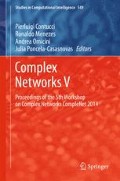Abstract
There are several metrics that are very useful to analyze and to design networks. These metrics, including the spectral-based ones, can be used to retrieve topological properties from the network. We observed that if one applies the Discrete Fourier Transform (DFT) over the eigenvalues of the Laplacian matrix, it is possible to observe different patterns in the DFT depending on some properties of the analyzed networks. In this paper, we propose a new metrics based on the entropy of the DFT samples, that can be used to identify the type of network. We evaluated this metrics in networks generated by four different procedures (k-Regular, Erdos-Renyi, Watts-Strogatz and Barabasi-Albert) and in well-known datasets of real networks. The results indicate that one can use the proposed metrics to identify the generational model of the network.
Access this chapter
Tax calculation will be finalised at checkout
Purchases are for personal use only
Preview
Unable to display preview. Download preview PDF.
References
Lewis, T.G.: Network Science - Theory and Applications. John Wiley & Sons (2009)
Albert, R., Jeong, H., Barabasi, A.L.: Error and attack tolerance of complex networks. Nature 406(6794), 378–382 (2000)
Sha, Z., Panchal, J.: Towards the design of complex evolving networks with high robustness and resilience. Procedia Computer Science 16, 522–531 (2013)
van Mieghem, P.: Graph Spectra for Complex Networks. Cambridge University Press (2011)
Cvetkovic, D.M., Gutman, I.: Selected topics on applications of graph spectra. Matematicki institut SANU, Beograd (2011)
Watts, D.J., Strogatz, S.H.: Collective dynamics of small-world networks. Nature 393, 440–442 (1998)
van Dam, E.R., Haemers, W.H.: Which graphs are determined by their spectrum? Linear Algebra and its Applications 373, 241–272 (2003)
Farkas, I.J., Derényi, I., Barabási, A.L., Vicsek, T.: Spectra of “real-world” graphs: Beyond the semicircle law. Phys. Rev. E 64, 026704 (2001)
Araújo, D.R.B., Bastos-Filho, C.A., Martins-Filho, J.F.: Towards Using DFT to Characterize Complex Networks. In: Proceedings of the XXXI Brazilian Symposium on Telecommunications, SBrT 2013, pp. 1–5 (2013)
Read, K.E.: Cultures of the central highlands. Southwestern J. of Anthropology 10(1), 1–43 (1954)
Zachary, W.W.: An information flow model for conflict and fission in small groups. Journal of Anthropological Research 33, 452–473 (1977)
Isella, L., Stehlé, J., Barrat, A., Cattuto, C., Pinton, J.F., Broeck, W.: What’s in a crowd? analysis of face-to-face behavioral networks. J. of Theoretical Biology 271(1), 166–180 (2011)
Michalski, R., Palus, S., Kazienko, P.: Matching organizational structure and social network extracted from email communication. In: Abramowicz, W. (ed.) BIS 2011. LNBIP, vol. 87, pp. 197–206. Springer, Heidelberg (2011)
Jeong, H., Tombor, B., Albert, R., Oltvai, Z.N., Barabási, A.L.: The large-scale organization of metabolic networks. Nature 407, 651–654 (2000)
Guimera, R., Danon, L., Diaz-Guilera, A., Giralt, F., Arenas, A.: Self-similar community structure in a network of human interactions. Physical Review E 68, 065103 (2003)
Author information
Authors and Affiliations
Editor information
Editors and Affiliations
Rights and permissions
Copyright information
© 2014 Springer International Publishing Switzerland
About this paper
Cite this paper
de Araújo, D.R.B., Bastos-Filho, C.J.A., Martins-Filho, J.F. (2014). Using the Entropy of the DFT of the Laplacian Eigenvalues to Assess Networks. In: Contucci, P., Menezes, R., Omicini, A., Poncela-Casasnovas, J. (eds) Complex Networks V. Studies in Computational Intelligence, vol 549. Springer, Cham. https://doi.org/10.1007/978-3-319-05401-8_20
Download citation
DOI: https://doi.org/10.1007/978-3-319-05401-8_20
Publisher Name: Springer, Cham
Print ISBN: 978-3-319-05400-1
Online ISBN: 978-3-319-05401-8
eBook Packages: EngineeringEngineering (R0)

